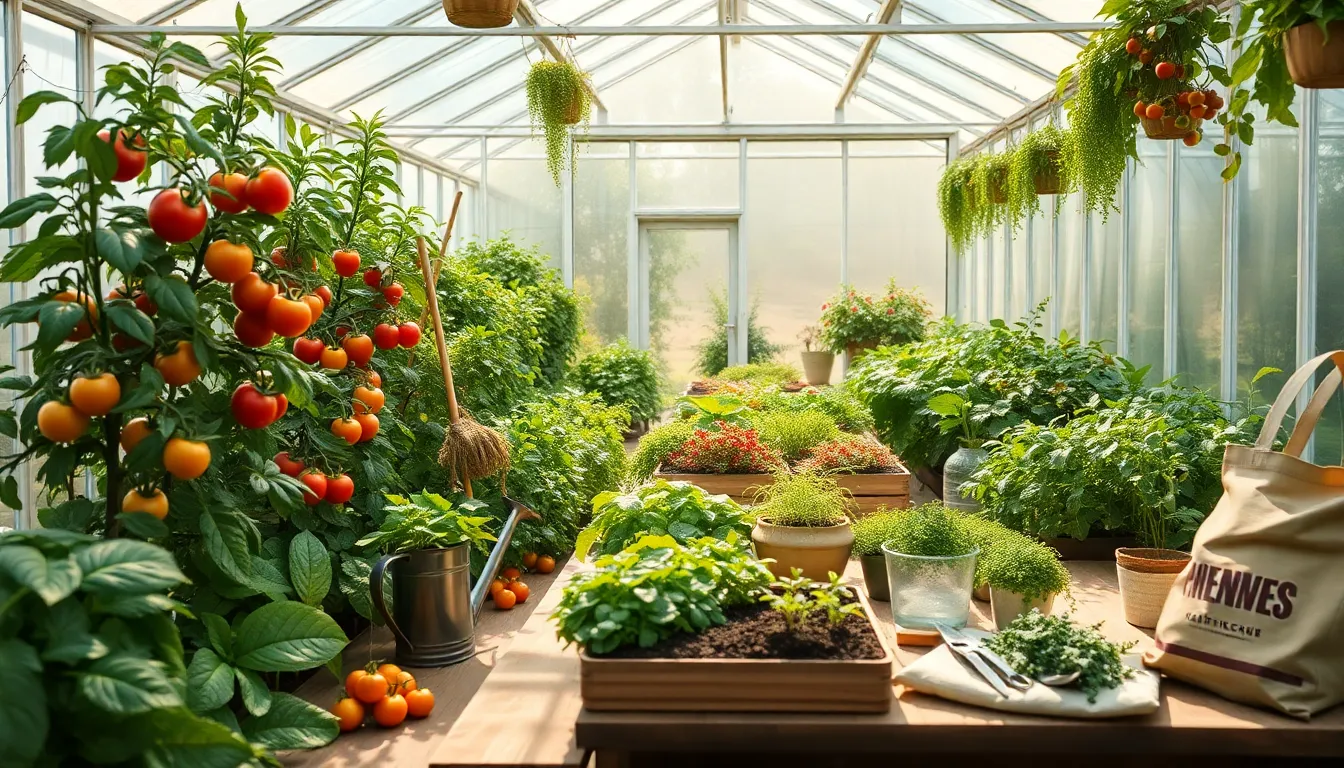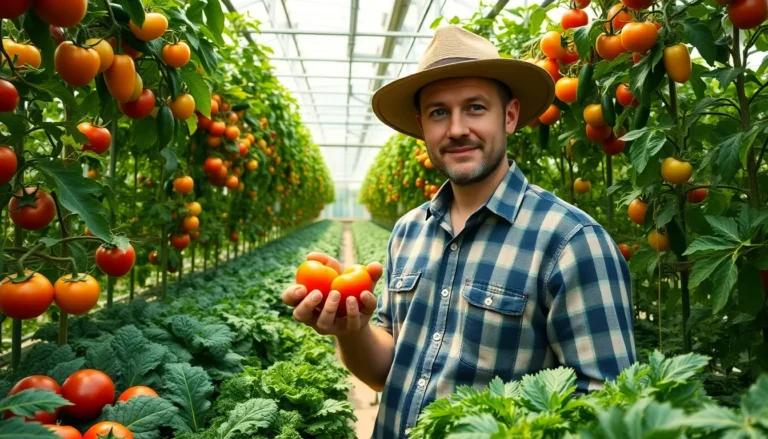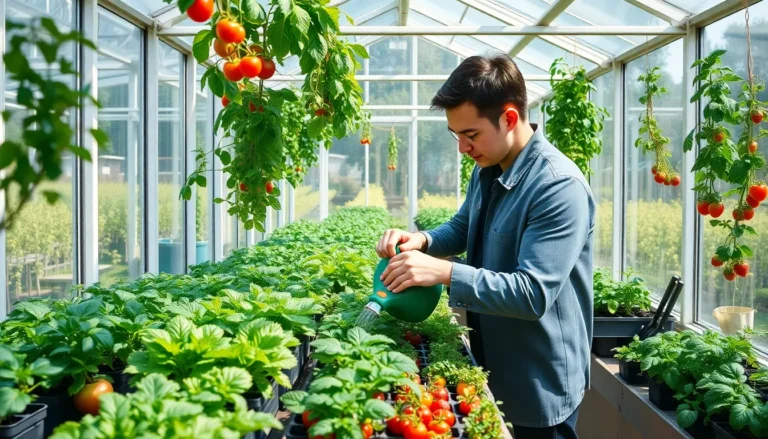Ever thought about turning your backyard into a mini Eden? Greenhouse gardening might just be your ticket to homegrown veggies, beautiful flowers, and a year-round gardening adventure. Imagine plucking fresh tomatoes in December or basking in the scent of blooming orchids while snowflakes dance outside your window. While it sounds idyllic, diving into greenhouse gardening doesn’t require a PhD in botany or a trust fund. Instead, it’s about getting your hands dirty and exploring what grows best under glass. So grab your favorite gardening gloves and let’s dig into the essentials.
Greenhouse Gardening For Beginners

Greenhouse gardening is an exciting way of cultivating plants in a controlled environment. Essentially, it’s a structure made of glass or plastic that traps sunlight, maintaining a warm climate to promote plant growth. With varying designs, from simple hoop houses to elaborate glass structures, anyone can find a style that suits their backyard or indoor space.
In a greenhouse, temperature and humidity can be tailored for specific plants, allowing even the most delicate species to thrive. Unlike traditional gardens that are at the mercy of seasonal weather changes, greenhouses provide a shield against extreme conditions. This means earlier springs and longer growing seasons, a real treat for anyone who’s ever nurtured a tiny seedling with hopes of future harvests.
Understanding this unique gardening method also involves recognizing how to balance environmental factors. Ventilation, shading, and heating are vital components of a successful greenhouse operation. It’s less about just having a glass house and more about creating a mini-ecosystem that caters to the flowerbeds or veggie plots planted within.
Benefits Of Greenhouse Gardening
Why opt for greenhouse gardening when there’s a perfectly good patch of dirt outside? Well, the benefits are as plentiful as the heirloom tomatoes you could grow.
Extended Growing Seasons: As mentioned, a greenhouse allows for an extended growing season. Instead of waiting for the last frost, gardeners can start their seeds sooner and enjoy fresh produce into the colder months. This isn’t just convenient: it’s the ultimate satisfaction of seeing your hard work come to fruition long after others have packed away their trowels.
Protection from Pests and Diseases: A greenhouse can act like a fortress for plants. With controlled entry points, it’s possible to keep out pesky insects and diseases that love to ravage open gardens. Think of it as a plant spa, minimized stress from environmental variables means healthier plants.
Diverse Plant Options: Got a penchant for exotic plants? A greenhouse lets you explore varieties that otherwise wouldn’t survive in local conditions. You can grow anything from miniature citrus trees to delicate orchids, transforming your gardening adventure into a fascinating journey of discovery.
Choosing The Right Greenhouse
Choosing a greenhouse is like picking the perfect pair of shoes: it should fit your needs and lifestyle. There are several types to consider:
- Freestanding Greenhouses: These structures stand alone and can be placed almost anywhere. They often offer more growing space, ideal for those planning to dabble in heavier gardening.
- Attached Greenhouses: If space is tight, an attached greenhouse can be a blessing. These are connected to your home, allowing for easy access and incorporating the warmth from your house.
- Portable Greenhouses: Perfect for beginners, portable options are lightweight and easy to set up. They can be moved according to the season or specific sunlight needs.
Also, consider the material. Glass greenhouses allow for beautiful light but can be pricier. Options like polycarbonate or PVC provide insulation yet may lack the aesthetic charm of glass. Eventually, it’s about aligning functionality with budget, so take time to weigh the choices.
Essential Supplies And Equipment
No gardener wants to be left in the dirt. A few essential supplies will help any beginner turn their greenhouse into a flourishing space:
- Heating Systems: Depending on climate, a heater might be essential. Electric or propane heaters keep the temperature consistent during chilly nights.
- Fans or Ventilation Systems: Proper airflow prevents overheating and allows for some refreshing breezes. Considering exhaust fans can help regulate temperatures and humidity levels.
- Timer Systems: For lights and watering equipment, timers simplify care. Who wants to be the one up at midnight ensuring the plants are fed?
- Thermometers and Hygrometers: Keeping tabs on temperature and humidity ensures the best environment for plant growth.
With these handy tools in place, beginners can focus more on nurturing their plants rather than worrying about technicalities.
Selecting Plants For Your Greenhouse
When it comes to plants, choose wisely. Beginners might think of going for easy-to-grow options to build confidence. But, this doesn’t mean settling for boring. Some fantastic beginner-friendly plants include:
- Tomatoes: Perfect for fresh salads, they thrive in greenhouses and can be grown in many varieties.
- Lettuce and Leafy Greens: Fast-growing and often forgiving, they thrive in controlled conditions, offering quick harvests.
- Herbs: Basil, parsley, and cilantro can bring flavor not only to your meals but also a delightful scent to your greenhouse.
Once a beginner gains confidence, they may want to explore more adventurous options like peppers, cucumbers, and even flowers. The key is to match plants with the care you’re ready to provide. Reading up on specific needs, light, temperature, and water requirements, before planting will set any gardener up for success.
Basic Maintenance And Care
For any gardening novice, maintenance is key to ensuring a thriving greenhouse. Here are some simple daily and weekly tasks:
- Daily Checks: Always assess temperature and humidity: make adjustments as needed. Plants, much like pets, thrive on attention.
- Watering: Depending on the plants, watering schedules can vary. It’s important to monitor soil moisture to avoid over- or underwatering.
- Cleaning: A clean greenhouse reduces disease. Regularly wipe surfaces and clear out any yellowed leaves or debris.
Adding fertilizer according to the plants’ growth stages can also maximize yields. As plants develop, they often need more nutrients, so keeping tabs on their health helps greatly.
Troubleshooting Common Issues
Even the most diligent gardeners may face challenges. Fortunately, there are simple solutions to common problems:
- Wet Leaves: If leaves appear soggy, it could be due to a combination of high humidity and poor airflow. Installing exhaust fans can help with circulation.
- Pest Invasions: A sudden bug party can wreak havoc on beautiful blooms. Regular inspections can catch issues early, and natural remedies like insecticidal soap may be the best course of action.
- Overcrowded Plants: Sometimes, plants grow more viably than expected. Ensure proper spacing to allow air circulation and light access: pruning may be beneficial too.
With a little patience and a keen eye, most issues can be resolved without much fuss.





